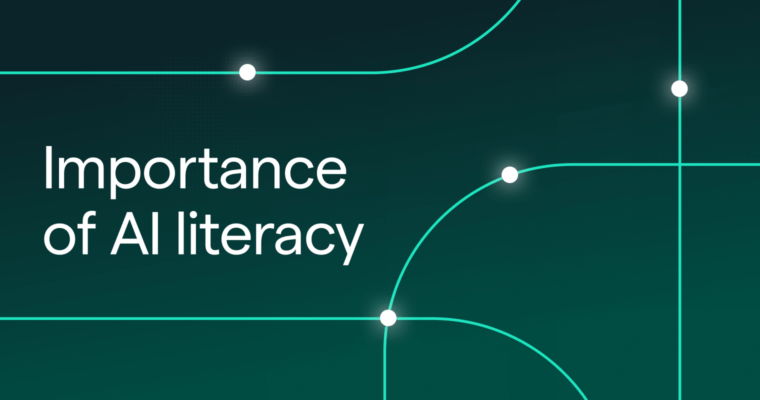The evolution of technology has brought rapid change to the sales landscape. For example, not long ago many sales teams heavily depended on writing cold emails and manually analyzing leads. Now, thanks to the power of AI, teams can draft cold outreach via generative AI and leverage automated lead-scoring systems that efficiently analyze and prioritize prospects based on their behavior and characteristics.
In this post, we’ll share more ways your sales team can integrate AI to improve its strategies, increase productivity, and drive better business outcomes.
What is AI in sales?
AI in sales moves away from traditional sales strategies and embraces technological advances—such as automated lead generation, predictive analytics, and personalized customer interactions—to optimize sales performance.
5 key changes AI brings to sales teams
1 Predictive sales analytics
AI replaces manual analysis with advanced algorithms to predict future sales trends, identify potential leads, and provide insights into which deals are more likely to close successfully. You can use this information in many ways, including improving your team’s customer relationship management (CRM).
For example, your team might use AI-driven insights on customer behavior to quickly identify potential cross-selling and upselling opportunities. AI can also suggest items that are frequently bought together or highlight relevant upgrades during the purchasing process to drive more efficiency in the sales cycle.
You can also use predictive analytics to understand patterns related to customer churn. For example, AI can analyze customer interactions, product usage patterns, and feedback to detect early signs of dissatisfaction or disengagement. This gives your team a chance to proactively address customer concerns, offer personalized incentives, and reduce churn.
Predictive analytics also play a crucial role in automating CRM systems by handling tasks such as data entry, lead scoring, and workflow optimization. By leveraging AI for sales automation, your team can concentrate on developing high-level strategy and building stronger relationships with customers.
Lastly, AI-driven CRM can integrate data from multiple systems into a single view, helping cross-functional teams gain a clearer picture of customer interactions and preferences. This can lead to improved decision-making and better customer experiences.
2 AI lead generation and qualification
Repetitive tasks—such as lead identification, scoring, and segmentation—can be time-consuming when done manually. By integrating AI into your company’s marketing and lead generation platforms, you can automate these tasks, creating a more efficient process and freeing up time to focus on nurturing leads that are most likely to convert.
AI can also quickly analyze vast amounts of data to spot patterns in the behaviors and preferences of your customers. With a deeper understanding of what motivates your target audience, you can create more personalized and effective engagement strategies.
You can also use AI to help you map out the buyer’s journey so you can address customer needs at different stages of the sales funnel. With insights into historical customer interactions, purchase patterns, and behaviors, you can ensure more timely and personalized interactions with prospects, ultimately increasing your conversion rate.
Here’s an overview of the techniques AI uses to identify and qualify potential leads:
- Lead scoring: AI algorithms analyze past customer interactions to identify patterns linked to successful conversions. Leads are then scored based on how likely they are to convert, enabling sales teams to prioritize high-potential leads and avoid wasting time on less promising prospects.
- Natural language processing (NLP): AI-powered NLP tools analyze text data from emails, social media, and customer interactions to decode customer sentiment. This information helps sales teams tailor their engagement strategies to better meet customer needs and preferences.
- Behavioral analytics: AI analyzes user behavior to identify patterns that indicate interest or intent to purchase. Sales teams can leverage these insights to qualify leads and understand the preferences of their prospective customers.
- Automated email campaigns: AI optimizes and personalizes email campaigns based on the recipient’s behavior and preferences. This ensures that leads receive relevant content, which can increase the chances of engagement and conversion.
3 Dynamic pricing and sales optimization
You can also use AI to adjust your pricing in real time to remain competitive and maximize sales revenue. AI does this by dynamically adjusting pricing based on its analysis of market conditions, customer behavior, and competitor pricing. It can also provide predictive insights into product demand so your company can optimize its inventory levels, reduce overstock, and ensure timely restocking of popular items.
Using AI for sales optimization not only maximizes sales revenue but also improves the customer experience by offering competitive pricing in real time. When companies offer dynamic pricing, their customers are more likely to feel they’re getting value for their money, which can support positive brand perception.
For example, airlines use AI for dynamic pricing to adjust ticket prices based on factors like demand, time until departure, and competitor pricing. This allows them to maximize revenue by offering competitive prices while also optimizing seat occupancy on each flight. When a travel company offers dynamic pricing, airline customers feel like they’re getting the best deals, making them more likely to choose that company for future travel needs.
There are potential drawbacks to AI-driven dynamic pricing, however, such as getting into price wars with competitors. To prevent unsustainable discounting, you should incorporate dynamic pricing as part of a comprehensive competitive strategy—not as a reactionary measure. By doing this, your company can reap the benefits of this technology without compromising profit margins or long-term sustainability.
4 Sales forecasting and revenue projection
AI uses advanced pattern-recognition capabilities to analyze data, identify trends, and generate accurate sales and revenue forecasting.
Instead of dedicating hours to manually inputting and analyzing data in spreadsheets, using AI can automate the process, saving you time and optimizing your team’s resource allocation. AI can even assist in identifying subtle patterns in customer behavior and market trends that may go unnoticed with more traditional forecasting methods.
With AI-driven forecasting, your team can also gain real-time insights that allow you to adapt your strategies based on the latest market developments. This ensures timely decision-making, keeping your business agile in response to dynamic market conditions.
Here’s an overview of the advantages of using AI for sales and revenue forecasting:
- Time efficiency: Automation reduces the time spent on manual data analysis, quickly generating comprehensive sales projections.
- Real-time insights: AI delivers up-to-the-minute data analysis, empowering teams to respond quickly to changes in the market.
- Scalability: AI-driven sales forecasting efficiently handles large volumes of data, which allows it to adapt to business growth and varying data requirements.
- Enhanced accuracy: AI leverages advanced pattern recognition, minimizing sales forecasting errors and providing more precise predictions.
- Cost savings: By automating repetitive tasks, AI reduces labor costs associated with manual forecasting methods, optimizing resource allocation.
5 Improving and expediting daily writing tasks
Sales is ultimately about building relationships, which requires careful, consistent, on-brand communication. Research shows that professionals like salespeople spend 88% of their workweek communicating. While a human touch will always be necessary, advances in AI can speed up these repetitive business writing tasks while minimizing miscommunication and ensuring that every professional email and internal communication message is clear, concise, and on-brand.
Here are a few ways Grammarly can act as a sales team’s AI writing partner:
- Impactful, polished communication: Grammarly goes beyond eliminating typos, grammatical errors, or awkward phrasing and makes strategic, real-time writing recommendations that ensure emails, proposals, and presentations deliver the most impact.
- Confidence in tone: Grammarly helps fine-tune the tone of writing, ensuring emails sound friendly and professional while maintaining a persuasive edge. Sales teams can also easily follow voice and tone guidelines by customizing Grammarly to make on-brand recommendations.
- Efficiency and speed: Grammarly works across more than 500,000 apps and websites, so communication stays on point wherever sales teams work. Sales professionals can use Grammarly to update a CRM platform, send a pitch email, communicate over Slack, and more—all without switching apps.
- Brand consistency: Enterprise-ready features like snippets, Knowledge Share, and style guides help teams deliver consistent messaging to customers and prospects while speeding up repetitive daily communication and easing internal communication.
Challenges and ethical considerations
While using AI in sales has many benefits, it also has challenges. Knowing what can go wrong will help your team proactively address potential issues so it gets the most out of this technology.
For example, feeding AI poor data can cause it to make inaccurate predictions, so it’s important to take steps to ensure you have high-quality data. This includes implementing rigorous data validation processes and ensuring your datasets are updated regularly to mitigate potential issues.
You should also be careful not to over-rely on AI for forecasting. Relying too much on AI could lead to a disconnect between the insights it generates and the nuanced understanding that human intuition provides. Using AI to complement your expertise—rather than replace it—will help align your decision-making with the broader business strategy.
Integrating AI systems with existing systems and data sources is another common challenge companies face. To address this, choose a solution that can integrate seamlessly with existing databases, APIs, and data formats your company uses.
Finally, there are ethical considerations when implementing AI into your sales processes, such as bias in algorithms. Here are a few examples:
- A predictive analytics tool might recommend products to certain customer groups, potentially alienating customers representing other demographics.
- AI-powered lead-scoring systems might reinforce biases by favoring leads from specific demographics, resulting in unequal opportunities for prospective customers.
- Language algorithms used in customer interactions might inaccurately interpret dialects or accents, excluding certain groups of people.
To prevent AI bias and ensure the ethical use of AI in sales, you should regularly audit algorithms and ensure your datasets are diverse. Consider studying up on responsible AI practices and potential biases so you understand how to effectively navigate ethical challenges. Lastly, you can take the extra step of working with ethicists and running external audits to thoroughly evaluate your AI systems for fairness.
Preparing for the future of AI in sales
AI is only beginning to transform sales. As AI capabilities continue to evolve, AI’s impact on sales processes will become even greater.
That said, salespeople will remain a valuable resource to companies, especially in complex sales scenarios where human intuition is critical. As AI technology becomes more robust, companies will need people who can navigate these developments to drive better efficiency, data analysis, decision-making, and overall business success.
Integrating some of the strategies above is a great place to start. This will help your team accumulate valuable data and experience to stay ahead of the curve as AI’s role in sales continues to grow.



